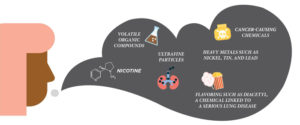People who use e-cigarettes breathe in and exhale aerosol that can contain harmful substances. According to the Centers for Disease Control, those substances include: nicotine, ultrafine particles, cancer-causing chemicals, heavy metals like nickel and lead, and volatile organic compounds. Sarah Smith with Prelude Behavioral Services says there’s been an increase in the number of teenagers using e-cigarettes and JUUL products. In 2016, 27% of Washington County 11th grade students had tried e-cigarettes, 8% in the previous 30 days. In 2018, nationwide 20% of high school students had used such products in the last 30 days. Smith says the trend is likely to increase locally and 2018 data will be released later this year.
Smith said a common misnomer, especially among youth, is that electronic cigarettes are safe to use, “With youth, they hear ‘vaping,’ and they hear that word and it sounds harmless, right? It’s just water vapor. But like I said, it’s actually aerosol.” The products often look like everyday items, like pens or USB flash drives.
Smith explains how much nicotine is in the electronic devices, “We also know that one of the JUUL pods contains as much nicotine as a pack of cigarettes. So, depending on how quickly they go through that pod, that’s how much they’re getting.” Smith adds that the impact on the body from inhaling the chemicals in the flavors is not yet known, as researchers are still studying the long-term health effects of e-cigarettes.
She encourages parents to talk early and often with their children about making smart choices and putting healthy things into our bodies.



